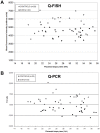Reduced placental telomere length during pregnancies complicated by intrauterine growth restriction
- PMID: 23326560
- PMCID: PMC3543434
- DOI: 10.1371/journal.pone.0054013
Reduced placental telomere length during pregnancies complicated by intrauterine growth restriction
Abstract
Objectives: Recent studies have shown that telomere length was significantly reduced in placentas collected at delivery from pregnancies complicated by intrauterine growth restriction secondary to placental insufficiency. Placental telomere length measurement during ongoing pregnancies complicated by intrauterine growth restriction has never been reported. This was the main objective of our study.
Methods: In our center, late chorionic villus samplings were performed between 18 and 37 weeks of amenorrhea in 24 subjects with severe intrauterine growth restriction (cases) and in 28 subjects with other indications for prenatal diagnosis (controls). Placental insufficiency was assessed by histo-pathological examination. Relative measurement of telomere length was carried out prospectively by quantitative Fluorescent In Situ Hybridization using fluorescent Peptide Nucleic Acid probes on interphase nuclei obtained from long-term cultured villi and with an automated epifluorescent microscope. A quantitative Polymerase Chain Reaction technique was performed to confirm the quantitative Fluorescent In Situ Hybridization results. The number of copies of gene loci encoding the RNA template (hTERC) and the catalytic subunit (hTERT) of the enzyme complex telomerase were also estimated in these placentas by Fluorescent In Situ Hybridization.
Results: Mean fluorescence intensity of telomere probes estimated by quantitative Fluorescent In Situ Hybridization was significantly less for cases compared to controls (p<0.001). This result indicated that mean telomere length was significantly reduced in placentas during pregnancies complicated by intrauterine growth restriction. Reduced telomere length was confirmed by the quantitative Polymerase Chain Reaction technique. No copy number variation of the hTERC and hTERT loci was noticed for cases, or for controls.
Conclusion: This study clearly demonstrates a reduction of placental telomere length in ongoing pregnancies (from 18 to 37 weeks of amenorrhea) complicated by severe intrauterine growth restriction secondary to placental insufficiency.
Conflict of interest statement
Figures



Similar articles
-
Evaluation of Quantitative Fluorescence in situ Hybridization for Relative Measurement of Telomere Length in Placental Mesenchymal Core Cells.Gynecol Obstet Invest. 2016;81(1):54-60. doi: 10.1159/000381896. Epub 2015 May 20. Gynecol Obstet Invest. 2016. PMID: 25998012
-
Telomere homeostasis in trophoblasts and in cord blood cells from pregnancies complicated with preeclampsia.Am J Obstet Gynecol. 2016 Feb;214(2):283.e1-283.e7. doi: 10.1016/j.ajog.2015.08.050. Epub 2015 Aug 28. Am J Obstet Gynecol. 2016. PMID: 26321036
-
Short telomeres may play a role in placental dysfunction in preeclampsia and intrauterine growth restriction.Am J Obstet Gynecol. 2010 Apr;202(4):381.e1-7. doi: 10.1016/j.ajog.2010.01.036. Am J Obstet Gynecol. 2010. PMID: 20350645
-
The long and short of it: the role of telomeres in fetal origins of adult disease.J Pregnancy. 2012;2012:638476. doi: 10.1155/2012/638476. Epub 2012 Oct 3. J Pregnancy. 2012. PMID: 23094159 Free PMC article. Review.
-
Telomere homeostasis in IUGR placentas - A review.Placenta. 2016 Mar;39:21-3. doi: 10.1016/j.placenta.2015.11.006. Epub 2016 Jan 2. Placenta. 2016. PMID: 26992670 Review.
Cited by
-
Increase in short telomeres during the third trimester in human placenta.PLoS One. 2022 Jul 13;17(7):e0271415. doi: 10.1371/journal.pone.0271415. eCollection 2022. PLoS One. 2022. PMID: 35830448 Free PMC article.
-
High-Risk Outcomes in In Vitro Fertilization Pregnancies for Women of a Very Advanced Maternal Age: Insights from a Multi-Hospital Study in Greece.J Clin Med. 2025 Feb 17;14(4):1323. doi: 10.3390/jcm14041323. J Clin Med. 2025. PMID: 40004853 Free PMC article.
-
Prenatal irisin is inversely related to the term placental telomere length.BMC Res Notes. 2025 Mar 8;18(1):102. doi: 10.1186/s13104-025-07118-1. BMC Res Notes. 2025. PMID: 40057798 Free PMC article.
-
Heterogenous Differences in Cellular Senescent Phenotypes in Pre-Eclampsia and IUGR following Quantitative Assessment of Multiple Biomarkers of Senescence.Int J Mol Sci. 2023 Feb 4;24(4):3101. doi: 10.3390/ijms24043101. Int J Mol Sci. 2023. PMID: 36834513 Free PMC article.
-
Placental telomere length and risk of placental abruption.J Matern Fetal Neonatal Med. 2016 Sep;29(17):2767-72. doi: 10.3109/14767058.2015.1103224. Epub 2015 Nov 26. J Matern Fetal Neonatal Med. 2016. PMID: 26611732 Free PMC article.
References
-
- Miller J, Turan S, Baschat AA (2008) Fetal growth restriction. Semin Perinatol 32: 274–280. - PubMed
-
- Barker DJ (1995) Intrauterine programming of adult disease. Mol Med Today 9: 418–423. - PubMed
-
- Barker DJ (2006) Adult consequences of fetal growth restriction. Clin Obstet Gynecol 49: 270–283. - PubMed
-
- Figueras F, Gardosi J (2011) Intrauterine growth restriction: new concepts in antenatal surveillance, diagnosis, and management. Am J Obstet Gynecol 204: 288–300. - PubMed
MeSH terms
Substances
LinkOut - more resources
Full Text Sources
Other Literature Sources

